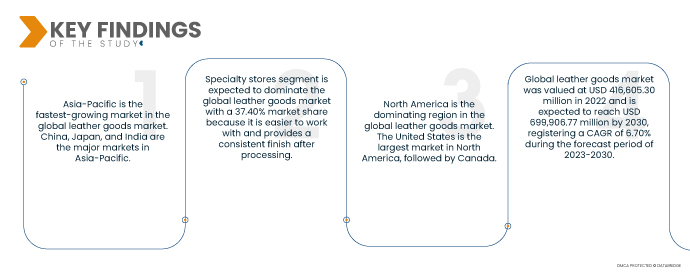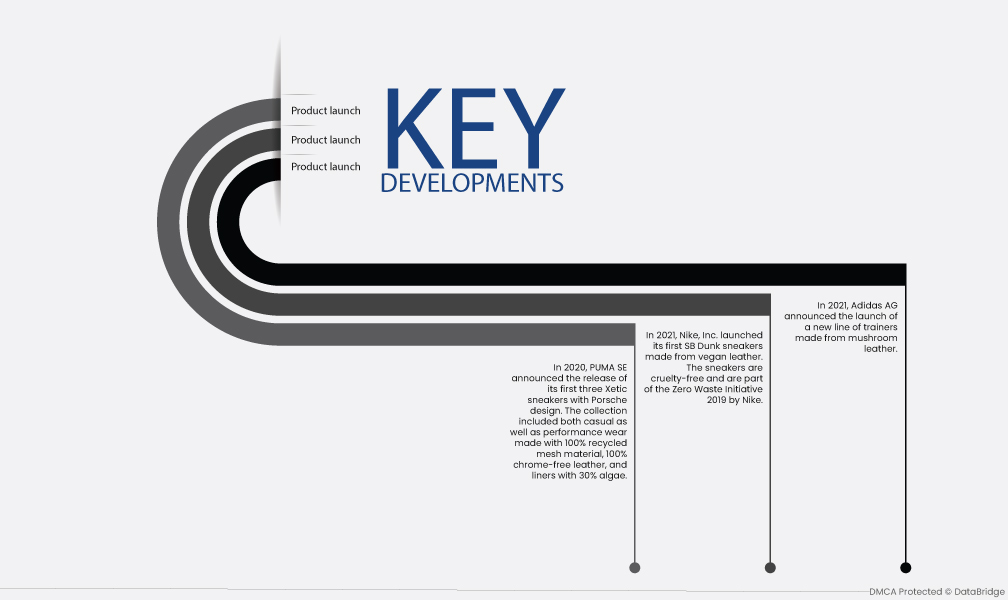With a market share of more than 39.3% in 2022, the footwear sector topped the market. Nike, New Balance, Adidas, Puma, Reebok, All Birds, and Converse are among the major players in the athletic footwear industry that have ventured into leather athletic production in response to rising customer demand for leather athletic footwear. For example, Nike, Inc. released trainers made from fly leather in 2017, a new material created by blending leftover leather scraps from tanneries with a polyester blend.
Access Full Report @ https://www.databridgemarketresearch.com/reports/global-leather-goods-market
Global Leather Goods Market was valued at USD 416,605.30 million in 2022 and is expected to reach USD 699,906.77 million by 2030, registering a CAGR of 6.70% during the forecast period of 2023-2030. Rising consumer disposable income, increasing living standards, changing fashion trends, and more domestic and international travel are the primary drivers of the market. Rising demand for comfortable, contemporary, and fancy leather garments, footwear, and accessories, as well as increased brand awareness, are projected to benefit the leather products industry.
Growing demand for luxury goods is expected to drive the market's growth rate
The rising demand for luxury goods is one of the major drivers of the global leather goods market. Leather goods are considered to be a symbol of luxury and status, and the increasing affluence of consumers in developing countries is driving the demand for leather goods. The increasing consumer preference for sustainable products is also driving the growth of the global leather goods market. Consumers are becoming more aware of the environmental impact of leather production, and they are increasingly opting for sustainable products made from alternative materials, such as vegan leather. The growing popularity of online shopping is also boosting the growth of the global leather goods market. Online retailers offer a wider range of products and more competitive prices than traditional brick-and-mortar stores, which is attracting more consumers to buy leather goods online.
Report Scope and Market Segmentation
|
Report Metric
|
Details
|
|
Forecast Period
|
2023 to 2030
|
|
Base Year
|
2022
|
|
Historic Years
|
2021 (Customizable to 2015- 2020)
|
|
Quantitative Units
|
Revenue in USD Million, Volumes in Units, Pricing in USD
|
|
Segments Covered
|
Product (Footwear, Handbags, Luggage, Apparel, Wallets, Belts, And Others), Leather Type (Full-Grain Leather, Top-Grain Leather, Genuine Leather, Split-Grain Leather, Bonded Leather, And Faux Leather), Grade (High-Grade And Low-Grade), Distribution Channel (Supermarkets/Hypermarkets, Company-Franchised Stores, Specialty Stores, E-Commerce, And Others)
|
|
Countries Covered
|
U.S., Canada and Mexico in North America, Germany, France, U.K., Netherlands, Switzerland, Belgium, Russia, Italy, Spain, Turkey, Rest of Europe in Europe, China, Japan, India, South Korea, Singapore, Malaysia, Australia, Thailand, Indonesia, Philippines, Rest of Asia-Pacific (APAC) in the Asia-Pacific (APAC), Saudi Arabia, U.A.E, South Africa, Egypt, Israel, Rest of Middle East and Africa (MEA) as a part of Middle East and Africa (MEA), Brazil, Argentina and Rest of South America as part of South America
|
|
Market Players Covered
|
Burberry Group Plc (U.K.), Capri Holdings Limited (U.S.) CHANEL (U.K.), Dolce and Gabbana Srl (Italy), Double R Bags (India), Giorgio Armani Spa (Italy), Hermes International SA (France), Kering (France), LVMH (France), Mulberry (U.K.), PRADA Group (Italy), Ralph Lauren (U.S.), Samsonite IP Holdings S.à r.l. (China), Tapestry Inc. (U.S.), Shree Satyanarayanji Impex (India), Frontier Bag Company (U.S.), Casco Manufacturing Solutions, Inc. (U.S.), Blivus Bags (India), Earthyy Bags (India)
|
|
Data Points Covered in the Report
|
In addition to the market insights such as market value, growth rate, market segments, geographical coverage, market players, and market scenario, the market report curated by the Data Bridge Market Research team includes in-depth expert analysis, import/export analysis, pricing analysis, production consumption analysis, and consumer behaviour
|
Segment Analysis:
The global leather goods market is segmented into four notable segments based on product, leather type, grade, and distribution channel.
- Based on product, the global leather goods market is segmented into footwear, handbags, luggage, apparel, wallets, belts, and others. Footwear segment is expected to dominate the global leather goods market with a 43.22% market share because they offer enhanced comfort and are eco-friendly, making these leather footwear more comfortable compared to synthetic shoes.
- Based on leather type, the global leather goods market is segmented into full-grain leather, top-grain leather, genuine leather, split-grain leather, bonded leather, and faux leather. Full-grain leather segment is expected to dominate the global leather goods market with a 41.53% market share because it is more breathable than other leather types, such as top grain and split grain leather.
- Based on grade, the global leather goods market is segmented into high-grade and low-grade. High-grade segment is expected to dominate the global leather goods market with a 57.02% market share because it is easier to work with and provides a consistent finish after processing.
The high-grade segment will dominate the grade segment of the leather goods market
The high-grade segment will emerge as the dominating segment grade segment. This is because of the growing number of footwear manufacturers in the market especially in the developing economies. Further, growth and expansion of research development services on a global scale will further bolster the growth of this segment.
- On the basis of distribution channel, the global leather goods market is segmented into supermarkets/hypermarkets, company-franchised stores, specialty stores, e-commerce, and others. Specialty stores segment is expected to dominate the global leather goods market with a 37.40% market share because it is easier to work with and provides a consistent finish after processing.
The specialty stores segment will dominate the distribution channel segment of the leather goods market
The specialty stores segment will emerge as the dominating segment under distribution channel. This is because of the growing number of infrastructural development activities in the market especially in the developing economies. Further, growth and expansion of the FMCG industry all around the globe will further bolster the growth of this segment.
Major Players
Data Bridge Market Research recognizes the following companies as the major market players: Burberry Group Plc (U.K.), Capri Holdings Limited (U.S.) CHANEL (U.K.), Dolce and Gabbana Srl (Italy), Double R Bags (India), Giorgio Armani Spa (Italy), Hermes International SA (France), Kering (France), LVMH (France), Mulberry (U.K.), PRADA Group (Italy), Ralph Lauren (U.S.), Samsonite IP Holdings S.à r.l. (China), Tapestry Inc. (U.S.), Shree Satyanarayanji Impex (India), Frontier Bag Company (U.S.), Casco Manufacturing Solutions, Inc. (U.S.), Blivus Bags (India), Earthyy Bags (India).
Market Development
- In 2021, Adidas AG announced the launch of a new line of trainers made from mushroom leather. The company has collaborated with biotech startup Bolt Threads, Stella McCartney, and lululemon to create plant-based vegan leather trainers. The sneakers are made from mycelium, the root-like structure of mushrooms, which is a sustainable and renewable material.
- In 2021, Nike, Inc. launched its first SB Dunk sneakers made from vegan leather. The sneakers are cruelty-free and are part of the Zero Waste Initiative 2019 by Nike. The initiative aims to reduce waste in the production of Nike products by 20% by 2025. The SB Dunk sneakers are made from a variety of recycled materials, including recycled polyester, recycled rubber, and recycled foam.
- In 2020, PUMA SE announced the release of its first three Xetic sneakers with Porsche design. The collection included both casual as well as performance wear made with 100% recycled mesh material, 100% chrome-free leather, and liners with 30% algae. The algae is used to provide cushioning and support.
Regional Analysis
Geographically, the countries covered in the market report are U.S., Canada and Mexico in North America, Germany, France, U.K., Netherlands, Switzerland, Belgium, Russia, Italy, Spain, Turkey, Rest of Europe in Europe, China, Japan, India, South Korea, Singapore, Malaysia, Australia, Thailand, Indonesia, Philippines, Rest of Asia-Pacific (APAC) in the Asia-Pacific (APAC), Saudi Arabia, U.A.E, South Africa, Egypt, Israel, Rest of Middle East and Africa (MEA) as a part of Middle East and Africa (MEA), Brazil, Argentina and Rest of South America as part of South America.
As per Data Bridge Market Research analysis:
North America is the dominant region in the leather goods market during the forecast period 2023-2030
North America is the dominating region in the global leather goods market. The United States is the largest market in North America, followed by Canada. The high demand for luxury goods, the increasing consumer preference for sustainable products, and the growing popularity of online shopping are the major factors driving the growth of the leather goods market in North America.
Asia-Pacific is estimated to be the fastest growing region in the leather goods market in the forecast period 2023-2030
Asia-Pacific is the fastest-growing market in the global leather goods market. China, Japan, and India are the major markets in Asia-Pacific. The rising demand for luxury goods, the increasing consumer preference for sustainable products, and the growing government support for the leather industry are the major factors driving the growth of the leather goods market in Asia-Pacific.
For more detailed information about the leather goods market report, click here – https://www.databridgemarketresearch.com/reports/global-leather-goods-market












